A THREE-PART VIDEO SERIES ON YOUTH HOMELESSNESS IN NEW MEXICO
VIDEOGRAPHER: KAELYN LYNCH
Nina Monarco, 17, doesn’t consider herself to be “from” anywhere.
Before coming to Serenity Mesa, a substance abuse treatment center in Albuquerque, New Mexico, the soft spoken, thoughtful teen said she moved every week or two since childhood, bouncing between family members, youth shelters, foster homes, and detention and treatment centers around the state and in neighboring Arizona.
Monarco said she comes from a family of alcoholics. She entered the child welfare system at age five, when her mother died in a drunk driving accident and her father, also struggling with addiction, was unable to care for Monarco and her brothers.
The cycle of trauma, neglect, and instability she experienced since then led to her own struggles with alcohol abuse, which landed her at Serenity Mesa. Now, she says he is committed to sobriety in hopes she can eventually get custody of her younger brother, who is in a foster home in Arizona.
“I’ve been through a lot since I was born,” Monarco said. “But this is the hardest thing I think I’ve ever had to do.”
Monarco is one of thousands of homeless and housing insecure youth in New Mexico, which consistently ranks toward the bottom among states for child welfare. In an under-resourced state with an overburdened system, a tight-knit group of nonprofit service providers have had to get creative to fill the gaps.
“I’ve worked in youth homelessness in big cities — New York, Los Angeles, Seattle — and I’ve never seen a community like we have here,” said Steven Serrano, program director at Casa Q, New Mexico’s only specialized shelter for LGBTQ+ youth.
VIDEOGRAPHER: KAELYN LYNCH
‘YOUTH HOMELESSNESS IS LARGELY HIDDEN’
The exact number of homeless and housing insecure youth is notoriously difficult to estimate.
Data collected by the federal Housing and Urban Development department only includes youth reported by homeless shelters or those on the streets. But experts say this doesn’t account for the many ways youth can experience homelessness.
According to the Voices of Youth Count, a national survey conducted by the University of Chicago, up to half of homeless youth ages 13 to 25 were exclusively bouncing between temporary accommodations with friends or family.
“Youth homelessness is largely hidden,” said Forrest Verde-Dudek, housing youth project manager for the New Mexico Coalition to End Homelessness. “They might not be flying a sign on the corner. They might be couch surfing with friends, staying in an abandoned building or living in an overcrowded house with family members without running water or heat.”
In New Mexico, no official count exists at a state-level, either.
But the data that does exist points to thousands of vulnerable young people.
According to a 2020 survey, some 9,500 New Mexico public school students between 11 and 18 were homeless or housing insecure. That number does not account for youth who have dropped out of school or those who are reluctant to self-report homelessness.
An April 2022 needs assessment for Bernalillo County, which includes Albuquerque, estimated there were between 1,088 and 2,314 housing-insecure individuals between the ages of 15 and 25 in the state’s most populous county. An official from the state’s Children, Youth and Families Department, which conducted the survey with the Pacific Institute for Research and Evaluation, cautioned against extrapolating the report’s findings to the rest of the state.
“We desperately need a statewide assessment,” said Hilarli Lipton, a senior advisor at CYFD, which oversees the state’s foster care system.
Youth homelessness presents differently than homelessness in adults, and the definition and age range vary depending on the institution conducting the research. But youth service providers throughout New Mexico agree on one thing when it comes to the data: It’s an undercount.
NONPROFITS FILL GAPS IN SERVICE
New Mexico is rural and under-resourced. It is among the poorest states in the country and ranks near or at the bottom on measures of education, health, and family and community, including 49th for overall child well-being.
“When we talk to providers from other states, they’ll casually refer to resources and we’re like, ‘Oh, that must be nice,’” said Catherine Hummel, executive director at Dreamtree Project, a youth shelter and housing program based in the northern New Mexico town of Taos. “It makes us all work together in a way we wouldn’t otherwise do.”
According to Hummel, those resources include a system of host homes, short-term foster care in a home-based setting, medium to long-term placements like group homes and a comprehensive and functional behavioral health system.
Currently, there are 12 officially licensed youth shelters in the entire state, amounting to 114 beds, many of which are full on any given night. The shelters are run entirely by nonprofits contracted through CYFD, and the lack of resources has birthed a unique, tight-knit relationship among the providers.
Available beds are tracked in a spread sheet, updated daily, that any child welfare worker in the state can access. Shelter heads have bi-weekly meetings to discuss individual cases and systematic issues, and often hop on triage conference calls to find emergency placements.
While the shelters are meant to be a stopgap, many of the providers have grown into their own youth-serving hubs.
“We do a really good job of finding a need and creating a program to fill it,” says Samuel Sisneros, street outreach program coordinator for New Day Youth and Family Services in Albuquerque.
In addition to their shelter, New Day has a drop-in center for homeless youth, with a gym, laundry facility, showers, lockers, and areas for doing art and taking a nap. They also host a life skills academy, with classes in everything from how to open a checking account to writing a rap song.
“We know that young people’s brains are not developed until the age of 25,” said Brooke Tafoya, New Day’s chief executive. “So we’re customizing and designing programs that are meeting them exactly at the developmental stage they’re at.”
Ultimately, though, shelters and drop-in centers are meant to be temporary solutions. According to their licensing, shelters are only supposed to house youth for up to 90 days, though shelters are able to extend that time by appealing to the licensing board.
“Everybody recognizes that children are better off in a family environment,” said Hummel, of Dreamtree in Taos. This is why the first step for both nonprofit service providers and state child welfare officials is to try and reunite youth with their families.
FAMILY REUNIFICATION NOT ALWAYS AN OPTION
In some cases, returning home is not a viable option.
Maya Fern, 22, is a youth outreach coordinator for the New Mexico Coalition to End Homelessness. From the ages of 14 to 18, she was living on the street, fleeing abuse at the hands of her mother’s boyfriend.
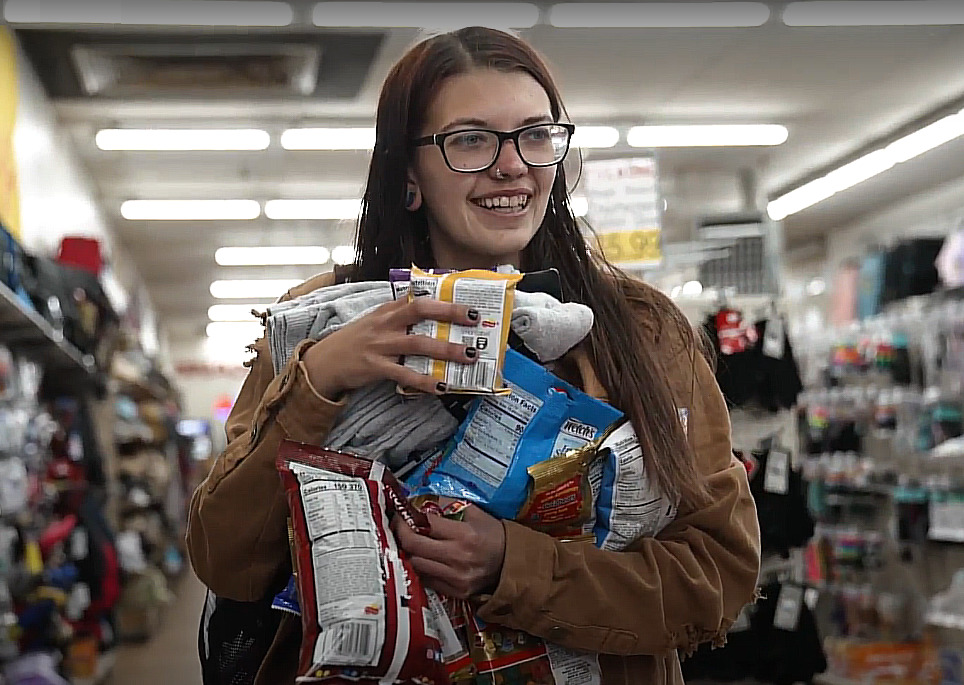
Video Screenshot: Kaelyn Lynch
Maya Fern holding snack foods she is buying to pass out to the homeless in Albuquerque, N.M.
After being hospitalized for a suicide attempt and telling nurses about the abuse, she was asked to testify against the boyfriend. Her mother, who was struggling with drug addiction at the time, told her she would no longer be welcome at home if she did.
Fern did not end up testifying, but she was not allowed back in her house, so she went to downtown Santa Fe and found a group of homeless teens and adults that took her in.
“They treated me better than my mom was at the time,” Fern said.
The system lost track of her until she was picked up by the police as a witness to a fight between two other homeless teens. The police tried to bring her back home, but her mother refused to even open the door, she said.
“Family reunification is big and important, but it’s not viable in all situations,” Fern said. “It wasn’t an option for me.”
According to Fern, there was no room at the youth shelter in Santa Fe, so the police brought her to the youth mental ward of a hospital in Albuquerque, where she stayed for two weeks, then an additional two when no one claimed custody of her.
Eventually, she was taken to a youth shelter in Albuquerque.
“I didn’t know anyone in Albuquerque, and the shelter was terrifying for me because I had become so used to my group in Santa Fe,” said Fern. She ended up hitchhiking back to Santa Fe, where she remained living on the streets.
“Even if there are kids just running away, there’s a reason they’re running away,” Fern says. “If they’re more comfortable going outside their house, there’s something that needs to be looked at there.”
CHILDREN UNDER 18 FACE UNIQUE HURDLES
For youth under 18 who can’t return home, there are limited options.
“They can’t sign a lease, so it’s literally impossible for them to access housing unless they’re in a program,” Tafoya said. And with a few exceptions, many of those long-term programs, such as rapid rehousing, which works with landlords to cover all or a portion of clients’ rent, are limited to young adults 18 and older. Many youth fleeing home also lack any form of ID and the documents, like birth certificates, to obtain them.
For system-involved youth in state or tribal custody, placement in a foster or relative’s household is the next option. But foster families, already difficult to come by, are even harder to find in a state where the median household income is a little over $50,000.
“There aren’t many families willing to take in a teenager — period, especially one who has been through trauma and needs special care,” Dreamtree’s Hummel said. “Given the level of poverty across New Mexico, it’s particularly challenging to find families with the resources to do that.”
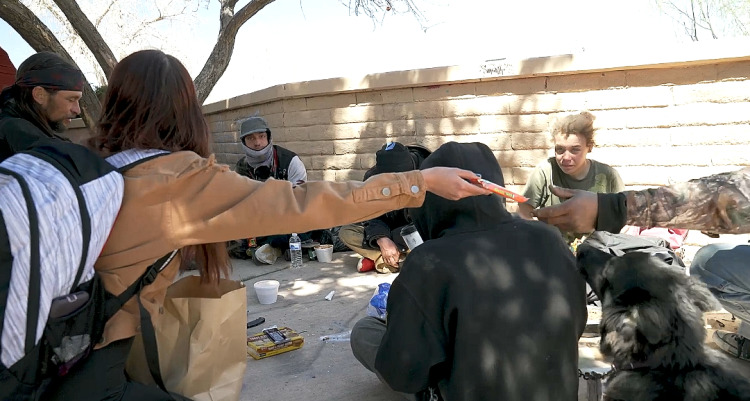
VIDEO SCREENSHOT:: KAELYN LYNCH
Fern hands out food to a group of homeless teens and young adults.
According to the New Mexico Substitute Care Advisory Council, there are 1,226 total relative and non-relative foster homes in the state, each of which are paid between $20 to $30 a day, depending on the level of care they are providing. The council notes that only 35.5 percent of kids in foster care find a permanent placement within two years, and they move foster care placements on average six times every 1,000 days.
The lack of available care in the state at large means that youth are often bounced around within and even out of state. According to CYFD’s Lipton, in 2019, around 200 kids — more than 10 percent of those in CYFD custody — were placed out-of-state in a foster family or treatment facility.
That number has decreased drastically since then — Lipton says there are only about 20 children currently out of state. But even youth who are able to remain in state are often sent hundreds of miles from their home communities for treatment or shelter.
Out-of-state placements were one of the practices targeted in a 2018 lawsuit brought against the state on behalf of 13 children in foster care. A settlement in March 2020 promised sweeping reforms to the state’s system, but two years later, many of those promised changes have not been implemented.
VIDEOGRAPHER: KAELYN LYNCH
Serrano of Casa Q said that the lack of long-term, stable care is one of the biggest barriers to breaking the cycle of youth homelessness.
Unlike other shelters, Casa Q is licensed as a multi-service home, meaning that youth that come into the program can stay as little or as long as they’d like, with the length of stay determined by individual need.
“We really knock down these barriers for kids, and they’re not the same people by the time they’ve left,” Serrano said. “But I can only do that because I have time. It takes a kid 30 days just to be able to look me in the eyes.”
He said a major barrier to creating more multi-service homes like Casa Q is the cost. This level of 24-hour care, which includes housing, medical care and case management, is expensive — about $35,000 per child, per month.
Another option is treatment centers, which cater to youth with behavioral health and substance abuse issues. But those are also in short supply compared to the need.
According to Diana Lopez, a vice president at Albuquerque-based Youth Development, Inc., the state’s largest and oldest youth-serving homeless organization, the problem dates back to 2013, when New Mexico’s 15 largest behavioral health providers, which provided almost 90 percent of services, were investigated by the state for medicaid fraud.
Funds were frozen and services were stopped. Even though all of the programs were eventually cleared, the damage was done, and most of the providers went out of business, leaving a gaping hole New Mexico’s healthcare system. The fallout was large enough to make national headlines and was even the topic of a 2019 documentary film, The Shake Up.
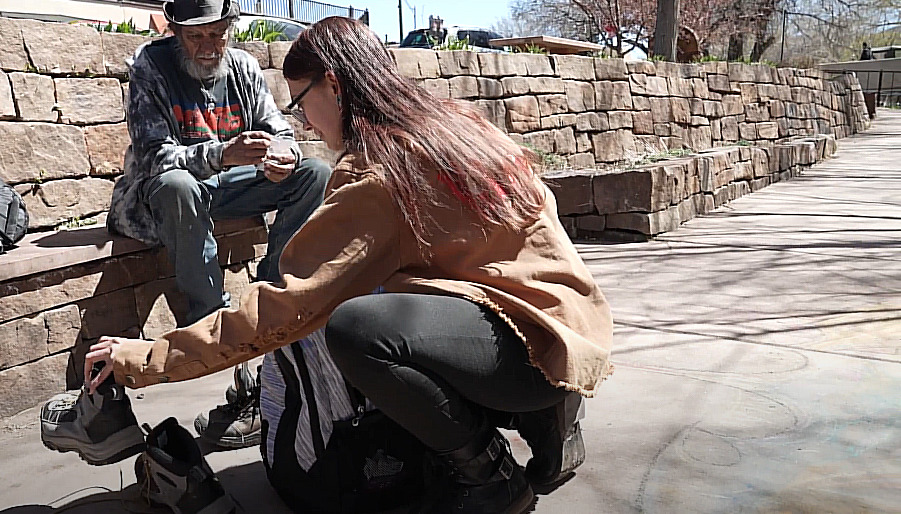
Video Screenshot:: Kaelyn Lynch
Fern and an older homeless man in Santa Fe, N.M. look to see which shoes will be the best fit for him.
“We always had the option of referring young people that needed longer-term care to behavioral health programs to help get them reintegrated back at home or find another placement for them, but those no longer exist,” Lopez said. “I think that’s a main reason why we’re seeing young people stay in our shelters longer than anticipated.”
Jennifer Weiss-Burke runs Serenity Mesa, the treatment center were Monarco is a resident. It’s one of the only substance abuse treatment centers left in the state for kids under 18 that works with homeless youth on Medicaid.
Weiss-Burke estimates that 98 percent of Serenity Mesa’s clients are housing insecure.
Substance abuse is one of the biggest factors influencing youth homelessness: According to data collected by the 2020 New Mexico Youth Risk and Resiliency Survey, about 70 percent of homeless high school students in New Mexico reported using drugs — twice the rate of those in stable housing. About thirty percent are binge drinkers — three times the rate of their peers.
For homeless teens like Monarco, Serenity Mesa provides not only treatment for addiction, but also much-needed stability and community. She said the three months she’s spent there is the longest she remembers staying in one place, but now she describes the other residents of Serenity Mesa as family.
“I never had friends before until I came here,” Monarco said. “We’re trying to better our lives and that’s just, like, perfect.”
COUNTDOWN TO ADULTHOOD
For other teens who slip through the cracks in the system, like Maya Fern, “it’s just a countdown to 18” when they can access housing programs, jobs and leases, she said.
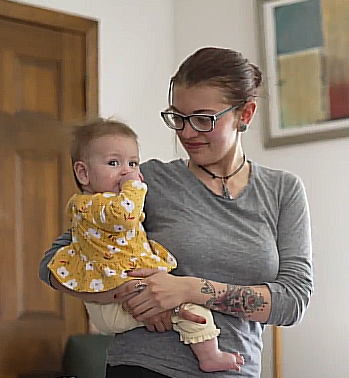
Video Screenshot:: Kaelyn Lynch
Fern holding her daughter at her mother’s house in Santa Fe, N.M. Fern, who was once estranged from her mother, reconciled with her as an adult.
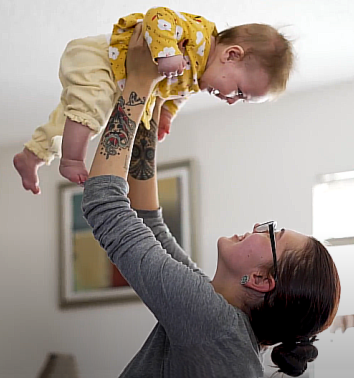
Video Screenshot:: Kaelyn Lynch
Fern holding her baby up in the air.
However, turning 18 does not automatically guarantee access to housing. According to the Voices of Youth Count, youth ages 18 to 25 experience homelessness at more than twice the rate of those ages 13 to 17. Waiting lists for housing programs are sometimes as long as a year, and rent is becoming less affordable even for those who are gainfully employed.
A portion of these homeless young adults are those aging out of foster care. As many as 46 percent of foster youth aging out of the system experience homelessness by the time they turn 26. To counter this, in 2020 New Mexico passed a law extending foster care, including guaranteed housing and food support, to the age of 21.
One of the results of the extended foster care system is Casa North, a transitional living program in Rio Rancho, a suburb of Albuquerque. A sprawling 5,000 square-foot home on three acres of land that can house up to 10 youth, Casa North is one of seven such homes throughout the state designed to provide housing-insecure youth ages 18 to 23 support as they transition to adulthood.
Youth that come from foster care, juvenile justice or referrals from shelters or other programs can stay in the home up to two years and receive what program manager Timothy Johnson calls a “one-stop shop” of services. In addition to food and housing, Casa North offers residents counseling, life skills, case management and help finding and paying for their own apartment once they leave.
“We don’t expect most kids to have their own market-priced apartment at 18, so why should we expect these kids to?” Johnson said. “In many cases, they weren’t taught or didn’t have the opportunity to learn those particular skill sets.”
Johnson said the state desperately needs more long-term programs like Casa North.
“Enacting more programs or finding the funding through legislature to enact more of these programs would help and go a long way,” he says. “Because if we don’t, these young adults end up becoming older adults in the same predicament.”
![]()
YOUTH TODAY’S THREE-PART VIDEO SERIES ON YOUTH HOMELESSNESS IN NEW MEXICO
• Watch Part One — Tackling youth homelessness in New Mexico
• Watch Part Two — “Serenity Mesa” ‘I try my hardest’: Homeless youth fight substance abuse in New Mexic
• Watch Part Three — “Casa Q” ‘There’s no safe place’: One queer youth shelter serves all of New Mexico
***
Kaelyn Lynch is a freelance multi-media journalist and videographer based in Santa Fe, New Mexico.





























